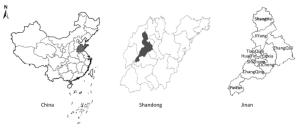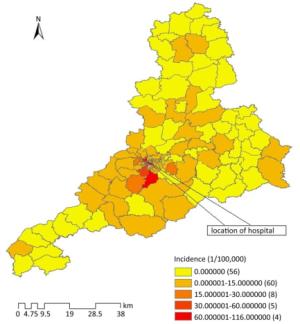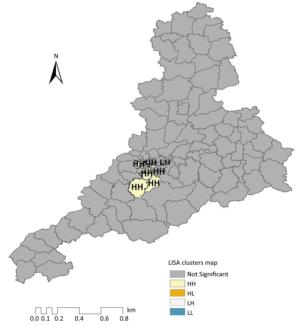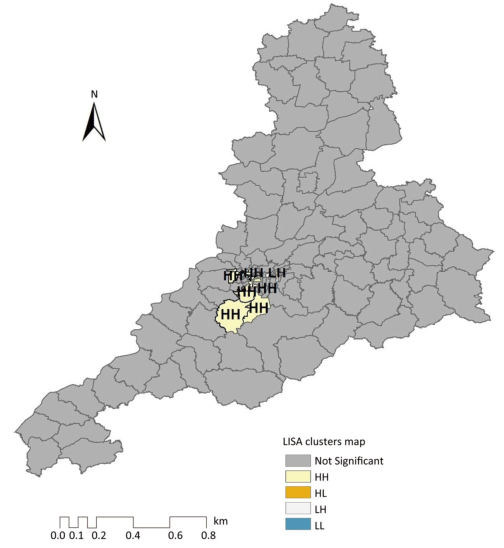-
Foodborne diseases (FBDs) represent a substantial, yet largely preventable, health burden and result in considerable morbidity and mortality in both developed and developing countries[1]. The FBDs Burden Epidemiology Reference Group (FERG) found that the global burden of FBDs is comparable to those of major infectious diseases, such as human immunodeficiency virus infection/acquired immune deficiency syndrome, malaria, and tuberculosis[2]. The Foodborne Disease Burden Epidemiology Reference Group (FERG), which established by the World Health Organization (WHO) found that there were 600 million foodborne illnesses and 420, 000 deaths caused by food hazards with a global FBD burden of approximately 33 million disability- adjusted life years in 2010[2]. In China, 9411.7 million cases of bacterial FBDs occurr every year, of which 3.357 million are hospitalized and 8, 530 die with a mortality rate of 9.1/100, 000[3].
Limited studies have been conducted on the local temporal and spatial distribution of FBDs using the available active surveillance data and no such epidemiological studies have been conducted in China. Given the availability of the new active surveillance data in Jinan, this study aimed to gain a better understanding of the epidemiological characteristics and spatio-temporal patterns of FBDs in Jinan.
Jinan is the capital city of Shandong Province in Northern China (latitude 36° 40' N, longitude 116° 57' E) (Supplementary Figure S1 available in www.besjournal.com). It is further divided into 10 districts and 134 township-level divisions, with a population of approximately 7 million[4].
Data were from two sentinel hospitals, i.e. Children's Hospital of Jinan City and Shandong Provincial Hospital, which reported an active FBD surveillance data during May-October from 2014 to 2016. Data included sex, age, place of eating, suspicious exposed food, and the onset date of symptoms of each notified case. The epidemic seasons of FBDs were the warm summer and autumn months. Thus, the study only analyzed the incidence data of FBDs in Jinan from May to October during 2014-2016[5]. All the cases were clinical cases (patients with daily defecation ≥ 3 times, abnormal stool, and with laboratory confirmation). The pathogens causing FBDs detected included norovirus, Salmonella, Shigella, Vibrio parahaemolyticus, and diarrheagenic Escherichia coli (DEC), including enterotoxigenic, enteropathogenic, enteroaggregative, enteroinvasive, and enterohemorrhagic E. coli). The methods and standards of the detection were mainly based on 'the work manual of national food microbial risk surveillance, 2014-2016'.
χ2 test, Shapiro-Wilk test, bivariate correlation analysis, and Pearson's correlation analysis were used in this study. The spatio-temporal distribution of the cases was analyzed based on the township-level polygon map of Jinan at a scale of 1:100, 000. We matched the map layers with latitude and longitude coordinates of the place of eating. To understand the spatial distribution pattern of FBDs, spatial autocorrelation and spatio-temporal cluster analyses were performed using the software Arcgis 10.0 (ESRI Inc., USA). SaTScan v. 9.1.1 (http://www.satscan.org/) was used to test whether a disease was randomly distributed over space, over time, or over space and time, and to identify any potential spatio-temporal clusters of the cases.
In this study period, a total of 334 confirmed FBD cases occurred. The average incidence of FBDs was 1.59/100, 000. Female cases accounted for 52.09% of all cases, and the incidence in women was 2.48/100, 000. There was no significant gender specific difference in the annual average incidence (χ2 = 3.746, P = 0.154). The age distribution of the cases changed significantly (χ2 = 33.482, P = 0.001), with the cases aged 21-40 years accounting for 46.71% of all cases. More than half (52.40%) of the FBD pathogens were DEC. Norovirus, bacteria/viruses, and V. Parahaemolyticus accounted for 25.75%, 8.98%, and 6.59%, respectively. The distribution of each FBD pathogen was significantly different (χ2 = 51.836, P < 0.001) (Supplementary Table S1 available in www.besjournal.com).
Characteristics of Patients 2014 2015 2016 Sex (χ2 = 3.746, P = 0.154) Female 56 (47.06) 62 (50.82) 56 (60.22) Male 63 (52.94) 60 (49.18) 37 (39.78) Age (years) (χ2= 33.482, P = 0.001) ≤ 10 30 (25.21) 17 (13.93) 2 (2.15) 11-20 5 (4.20) 15 (12.30) 6 (6.45) 21-30 36 (30.25) 31 (25.41) 35 (37.63) 31-40 16 (13.45) 20 (16.39) 18 (19.35) 41-50 8 (6.72) 6 (4.92) 11 (11.83) 51-60 10 (8.40) 17 (13.93) 11 (11.83) ≥ 61 14 (11.76) 16 (13.11) 10 (10.75) Pathogens (χ2= 51.836, P < 0.001) Norovirus 27 (22.69) 41 (44.09) 18 (14.75) Salmonella 1 (0.84) 3 (2.46) 15 (12.30) Shigella 0 (0) 0 (0) 0 (0) parahaemolyticus Vibrio 8 (6.72) 9 (7.38) 5 (4.09) diarrheagenicescherichia coli 73 (61.34) 53 (43.44) 49 (40.16) Bacteria/virus 10 (13.11) 16 (13.11) 4 (3.28) Bacteria/Bacteria 0 (0) 0 (0) 2 (1.64) Table Supplementary Table S1. Demographic Characteristic of Foodborne Diseases Cases in Jinan, 2014-2016 (May-October)
The proportions of suspicious exposed foods consumed by the FBD cases varied with year (χ2 = 60.379, P < 0.001). There were four major suspicious exposed foods with proportions higher than 10.00%, i.e. meat products (21.56%), seafood (17.07%), fruits (15.57%), and dairy products (10.18%) (Supplementary Table S2 available in www.besjournal.com).
Suspicious Exposed food 2014 2015 2016 Total Meat products 29 (24.37) 24 (19.67) 19 (20.43) 72 (21.56) Seafood 13 (10.92) 21 (17.21) 23 (24.73) 57 (17.07) Fruits 15 (12.61) 24 (19.67) 13 (13.98) 52 (15.57) Dairy products 27 (22.69) 4 (3.28) 3 (3.23) 34 (10.18) Vegetables products 6 (5.04) 16 (13.11) 4 (4.30) 26 (7.78) Food products 9 (7.56) 6 (4.92) 4 (4.30) 19 (5.69) Beverages and frozen drinks 3 (2.52) 5 (4.10) 4 (4.30) 12 (3.59) Eggs products 1 (0.84) 5 (4.10) 1 (1.08) 7 (2.09) Beans products 2 (1.68) 1 (0.82) 2 (2.15) 5 (1.50) Mixed food 8 (6.72) 12 (9.84) 11 (11.83) 31 (9.28) Varieties of food 1 (0.84) 3 (2.45) 7 (7.53) 11 (3.29) Other food 5 (4.20) 1 (0.82) 2 (2.15) 8 (2.39) Table Supplementary Table S2. Uspicious Exposed Food of Foodborne Diseases Cases in Jinan, 2014-2016 (May-October
The first three streets/towns with high incidences of FBDs were Erqi Street (115.26/100, 000), Shiliulihe Street (88.10/100, 000), and Wuligou Street (76.30/100, 000).
FBD cases in Jinan from May to October during 2014-2016 showed a non-random distribution in space. Figure 1 shows the incidences of FBDs in Jinan from May to October during 2014-2016.
The global Moran's I index was 0.233272 (P < 0.001), suggesting a positive correlation space of incidence of FBDs at the significance level of 0.05. The global Moran's I indices were 0.205300, 0.194662, and 0.1166042 (P < 0.001), indicating a positive correlation space of the incidence of FBDs during 2014-2016 at the significance level of 0.05 (Supplementary Table S3 available in www.besjournal.com).
Year Moran's I Z Value P Value 2014 0.205300 12.314307 < 0.001 2015 0.194662 11.675823 < 0.001 2016 0.166042 10.206586 < 0.001 Table Supplementary Table S3. Spatial Autocorrelation Analyses for Annualized Incidence of Foodborne Diseases in Jinan, 2014-2016 (May-October)
As shown in Figure 2, the local Moran's I index was significant in 14 high-high (H-H) cluster areas, i.e. Zhongda Street, Zhenxing Street, Kuangshan Street, Erqi Street, Shiliulihe Street, Ganshiqiao Street, Dangjia Street, Weibeilu Street, Dikoulu Street, Qixian Street, Daode Street, Xishichang Street, Zhangjialu Street, and Wuligou Street. There were 2 low-high (L-H) cluster areas (Yanshan Street and Daminghu Street).
SaTScan statistics for spatial clusters showed that spatial clusters were with significantly higher incidences of FBDs. There was little change in the locations of these clusters. The most likely spatial cluster with significantly higher incidence wasin western Jinan. Most likely, the size of the spatial clusters expanded in 2015 and 2016.
The space-time scan statistics based on a Poisson model were used to detect statistically significant spatio-temporal clusters with high incidences of FBDs. Table 1 showed that there was most likely one space-time cluster each year with significantly higher incidence in Jinan. We observed that there was most likely a statistically significantcluster in the western region of Jinan from June 14 to September 10 in 2014 [relative risk (RR) = 14.32, P < 0.001].
Cluster Year Time Frame Town Numbers Observed Cases Expected Cases Relative Risk P Value Most likely 2014 14/06/2014-10/09/2014 5 15 1.19 14.32 < 0.0001 Most likely 2015 03/08/2015-20/10/2015 8 26 4.28 7.45 < 0.0001 Most likely 2016 06/05/2016-02/08/2016 8 31 3.19 9.69 < 0.0001 Table 1. SaTScan Statistics for Space-time Clusters with Significantly Higher Incidences in Jinan, May-October, 2014-2016
In 2015, the statistically significant cluster was most likely in the western region of Jinan from August 3 to October 20 (RR = 7.45, P < 0.001). In 2016, the statistically significant cluster was most likely similar to significant cluster in 2014 and 2015 from May 6 to August 2 (RR = 9.69, P < 0.001). The statistically significant clusters most likely included Wuligou Street, Xishichang Street, and Dikoulu Street (Huaiyin District) every year, which indicated that Huaiyin District was a area with high incidence of FBDs.
According to the Shapiro-Wilk test, we chose Spearman's correlation analysis, the results indicated that there were positive correlations between the FBD case number and average temperature (r = 0.303, P < 0.001) and average humidity (r = 0.129, P < 0.001). The incidence of FBD hada negative correlation with gross domestic product (GDP) (r = -0.230, P < 0.001) anda positive correlation with population density (r = 0.587, P < 0.001) based on Spearman's correlation analysis.
Our study found that the age distribution of the cases changed significantly, and nearly half of the cases were individuals aged 21-40 years, indicating that this age group is more susceptible to FBDs than other age groups. It is possible that young people have more opportunities to dine out and are well aware of medical care.
This research indicates that the main pathogens of FBDs are DEC and norovirus in Jinan. Marder E has found that DEC is a major pathogen causing bacterial gastroenteritis in children[6], and considerable research efforts have found that norovirus often causes FBD outbreaks in schools and restaurants, among others[7], indicating that we should take effective measures for the prevention and control of the outbreaks of FBDs caused by two pathogens, especially noroviruses. In addition, our study found that there were many mixed-pathogen infection cases, which might be related to the diversity of dietary structures and variety of cooking methods in China.
Four major suspicious exposed foods were identified, i.e. meat products, seafood, fruits, and dairy products, the results were consistent with previous studies[8]. Due to poor hygiene and sanitation, food is easily contaminated by pathogens. Meat and dairy products are considered to be the infection sources of pathogens, such as Salmonella enterica and DEC[7]. Seafood consumption and uncooked seafoods are recognized as the leading causes of V. parahaemolyticus infection, resulting in human gastroenteritis.
Our results demonstrate that the incidences of FBDs had positive spatial autocorrelation at township level in Jinan. The results of scan statistical analysis showed that there were non-randomly distributed clusters in space and space-time in the detection of the cases. Statistical difference and clustering maps can visualize spatial autocorrelation analysis results, which is consistent with the high incidence of FBDs by basic thematic maps. This might be related to more restaurants and catering industries and more opportunities of eating out in these areas. High incidences and clusters indicate a potential outbreak of diseases[9]. Therefore, we should pay more attention to the potential outbreaks in western Jinan, especially in areas at high-risk. We found that the most likely spatial cluster with significantly higher FBD incidence was in the western region of Jinan and changed very little during the study period. However, the sizes of spatial clusters most likely expanded in 2015 and 2016. Thus, more attention and control measures should be paid to the prervention and control of FBDs in this area.
The number of FBD cases is positively correlated with average temperature and relative humidity. As is known, warm and moist environments could be beneficial to the propagation of foodborne pathogens[10]. Correlation analysis also suggestedthat the incidence of FBDs was positively related with population density and negatively related with GDP, consistent with the observation from the results of spatio-temporal analysis. Western areas of Jinan has lower GDP and higher population density than other areas.
There are some limitations in our study. The active FBD surveillance network was not esiablished until 2013 in Jinan. Thus, we only had access to the data from 2014-2016. Due to the voluntary nature of the reporting system of FBDs in two sentinel hospitals, we did not have access to the data of all FBD cases in Jinan. In addition, because of the limitations in the reporting system, more detailed information about individuals' socio-economic status was not available. We did not have access to more detailed information of the patients such as their education level, ethnic group, and other influencing factors.
In conclusion, our study revealed the epidemiological characteristics of FBDs and identified spatio-temporal high-risk clusters of FBDs in Jinan and risk factors using the FBD surveillance data from 2014 to 2016. The findings can assist in the development of FBD prevention and control strategies, and provide new evidence for policy-making to improve the current surveillance system with a focus on identified areas and subpopulations at high risk.
Epidemiological Characteristics and Spatio-temporal Patterns of Foodborne Diseases in Jinan, Northern China
doi: 10.3967/bes2019.042
- Received Date: 2018-08-09
- Accepted Date: 2019-03-06
| Citation: | YANG Li, SUN Yan Bin, ZHONG Qing, DUAN De Shui, LIU Shou Qin, ZHANG Ying. Epidemiological Characteristics and Spatio-temporal Patterns of Foodborne Diseases in Jinan, Northern China[J]. Biomedical and Environmental Sciences, 2019, 32(4): 309-313. doi: 10.3967/bes2019.042 |











 Quick Links
Quick Links
 DownLoad:
DownLoad:

